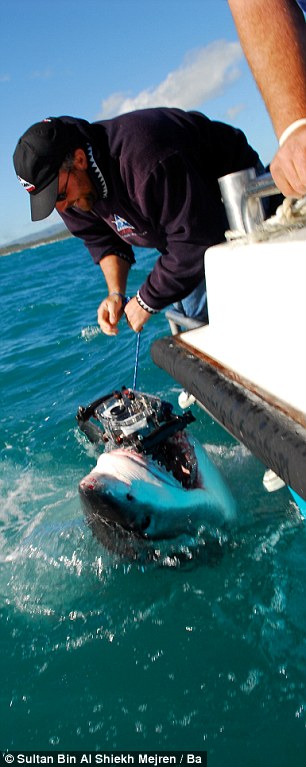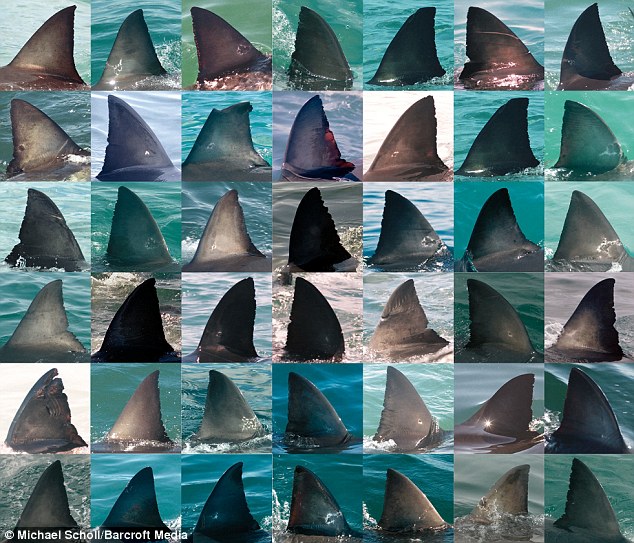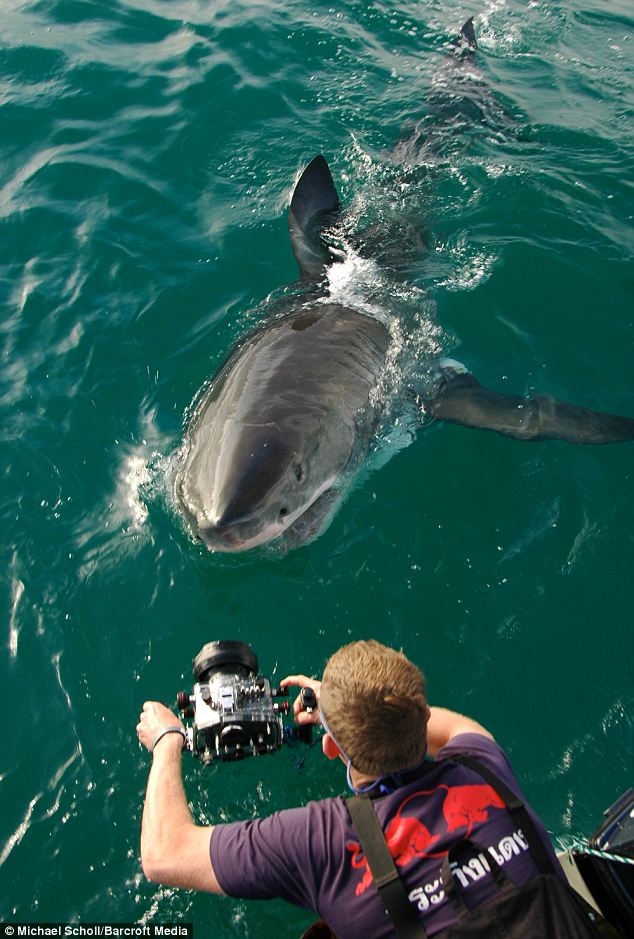This is the amazing moment a scientist got just a little too close to a shark he was trying to photograph – and the deadly predator attempted to eat his camera.

A great white shark bites Michael’s camera as he tried to photograph it for his finprinting project in the sea off Dyer Island, South Africa
Marine biologist Michael Scholl was documenting great white sharks off Dyer Island in South Africa when the hair-raising incident happened.
Scholl is part of an international team of scientists is building an extraordinary new computer system that can identify every single member of one of the world’s most feared predators – the Great White Shark.
Led by a British university, the system could lead to tourists helping international shark experts to track the animals.
The University of Bristol is developing software that will automatically recognise individual dorsal fins of animals swimming in the world’s oceans.
For the first time it will add to a central database that experts hope will give them a unique insight into the species’ population and their movements.
It is hoped that the unparalleled record of the sharks and their territories could help discover the truths behind behaviours never witnessed – including mating or giving birth.
These pictures show Swiss marine biologist Michael Scholl, founder and director of the White Shark Trust, who spent 10 years photographing more than 1,500 Great Whites using his ‘finprinting’ technique.
His detailed observations, paired with a dorsal fin ID for each animal, is the world’s largest database on the sharks.
Mr Scholl’s project, based on Dyer Island, South Africa, used physical features on each fin to distinguish between individuals and record their identity.
Other researchers have performed similar studies, but the International White Shark PhotoID Project Group aims to combine the information and automate the ID process.
Mr Scholl said: ‘A huge problem we have is that there are really only around 10 people working on great whites full-time in the field.
‘Having a system that people can log into using the internet means that we will add potentially thousands of people to the team of data gatherers.
‘I have lived in South Africa for a number of years and there are great numbers of tourists going out on expeditions to see these sharks.

Unique: A new computer system will allow scientists to track individual Great White sharks by automatically recognising their fins
‘At a recreational and educational level, imagine how satisfying it would be to take a picture of the sharks you see on your trip and then go home to find out about that individual shark and where else it has been spotted.’
Mr Scholl and the other members of the project also hope that the new system will lead to better protection for the sharks.
Currently they are safeguarded in some national waters, but are not protected elsewhere – even in international waters just a few miles off shore.
He added: ‘The new database will result in the best and most accurate population size estimate which is extremely important in order to convince politicians and legislators, such as fisheries, to protect this species on an international scale and not just on a national scale.’
An estimated 100 million sharks are slaughtered every year around the globe.

Database: Scientists hope that tourists will be able to add to the log of Great White information to discover where they give birth
‘This issue the most important one,’ said Mr Scholl. ‘Shark populations of all species, anywhere in the world, are under threat from human activities, especially the finning industry.’
Dr Tilo Burghardt, an expert in visual animal biometrics from the university’s department of computer science, said the group is aiming for computers to automatically recognise features of white shark dorsal fins.
Using ‘Computer Vision’ technology – similar to new gadgetry being used with the Xbox 360 games console – means human researchers will not be required to enter the data to build the database once it is ready.
Instead, ‘Computer vision’, which is concerned with new technology that allows artificial systems to automatically recognise and extract information from images, will do the work and archive the animal information along with their IDs.
Dr Burghardt said: ‘We are already writing the software.
‘The database is important because collecting data by taking a photograph of a dorsal fin is comparatively simple, photo identification much less invasive than methods like tagging and reduce stress in the sharks, and we can use computers to solve the identification process.’

Mystery: Marine biologist Michael Scholl, who has spent 10 years photographing Great White sharks in a bid to discover their movements and population number





